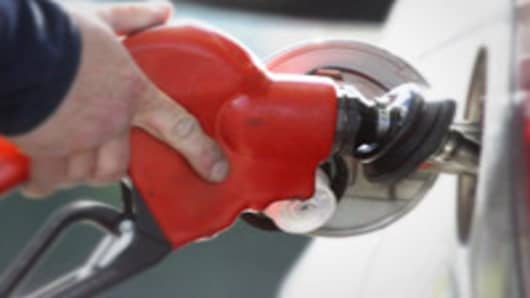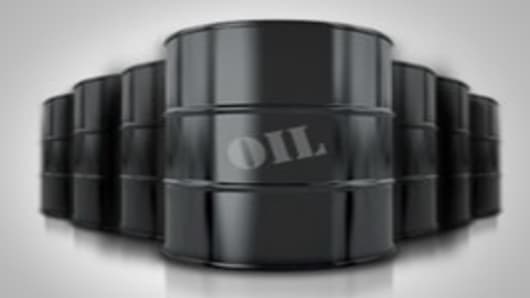Falling gasoline prices are one silver lining for an economy that is, at best, chugging along.
The national average for regular gasoline has fallen 9 cents in the past week to $3.41, according to AAA. Gasoline was $3.65 a month ago and $3.935 a gallon when it peaked in April. The decline is expected to continue, and gasoline could fall below $3 a gallon this fall, said Andrew Lipow, president of Lipow Oil Associates.
“I would say if it wasn’t for falling gas prices, there might be more talk that the slowdown is more concerning than it looks,” said Credit Suisse economist Jonathan Basile. “That’s keeping some of the other concerns at bay.”
Gasoline prices are falling with crude but also because the market is well supplied with a high refinery run rate in the U.S. above 90 percent.
“It’s the general economic concerns that are causing the oil prices to go down, the faltering economy in China, the euro concerns, and in the United States in particular, week on week gasoline demand is just continuing to go down,” said John Kilduff of Again Capital. “Some weeks in particular, gasoline demand is down 6 percent…with the lower price I would expect demand to pick up a bit.”
Lipow said he expects to see gasoline demand drop by 2.5 percent for the year, after having declined by about 4 percent last year.
“The rate of decline is slowing, but it continues to decline, and that is in conjunction with people driving less due to higher prices,” he said. “Clearly, the continued increase in efficiency in cars is going to result in a gasoline demand decline of a half to 1 percent every year, and that’s despite the growing population and more cars on the road.”
Every 1 cent move in gasoline prices has an impact on the economy.
“For household spending, it frees up a little bit more than a billion dollars of consumer spending,” said Basile. But that doesn’t mean consumer spending will increase, as the spending could just shift to other categories, and more discretionary items could see more.
But Basile said he’s especially watching the consumer this week, in consumer confidence, expected Tuesday at 10 a.m. EST and in Friday’s personal income and spending data.
“We’ve seen consumer sentiment hit a wall in June, and the times when you see sentiment, or confidence go down, that means consumers tend to be a little more adverse to spending. They tend to save more,” he said.
He therefore expects to see Fridays’ real consumer spending data for May flat, compared to a 0.3 percent gain in real spending in April. He expects consumer confidence to fall to 58 from 64.9 last month.
“It’s like a stabilizer in the economy, but you also don’t want to see gasoline prices falling persistently because that will tell you there’s got to be something else fundamentally wrong in the global picture,” Basile said. “Gasoline prices are the most visible prices in the economy. People see it...It’s very easy to see lower prices. That’s the good news. But you have to put it into the context of what’s going on.”
Declining oil prices are the biggest contributor to falling gasoline prices. West Texas Intermediate was trading below $79 per barrel Monday, and Brent, the international benchmark was trading at around $90.
The slowing world economy is one factor behind the drop in oil prices, but the world has also been pumping a record amount of crude. The International Energy Administrationreported a record 91.1 million barrels of production a day in May, while demand was lower at 89.9 million barrels.
Saudi Arabia has been pumping more than usual, in response to sanctions on Iran. Europe’s sanctions on Iranian oil take effect July 1, but there has already been a decline in Iranian imports of about one million barrels per day in April and May, from last year’s levels, according to the IEA. Iran had been exporting about 2.3 million barrels a day.
Falling Gas Prices
The other factor is that more oil production is coming from places like Iraq and Libya. On the domestic front, there has also been a big increase in production. Lipow said U.S. production is now at a 13-year high of about 6.4 million barrels a day, an increase of 14 percent over last June.
“The low price point will probably be here in July and August,” said Kilduff, who says WTI could break $70. He said demand should then pick up in the fall, as diesel demand rises ahead of the holiday season and heating oil demand picks up.
Even the threat of Tropical Storm Debbydisrupting production in the Gulf of Mexico did not help oil prices Monday.
“On the crude side we have plenty of it, and the Gulf of Mexico supplies less and less,” Lipow said. “It’s roughly about 1.4 million barrels a day.”
Refining output had also been an issue when gasoline prices were running higher earlier in the year, and the threat of refinery shutdowns on the East Coast added to concerns.
“They’re a little tight here on the East coast, but overall we’re well supplied. We have plenty coming on with the run rate the way it is,” Kilduff said.
One disappointment has been the Motiva refinery, owned by Royal Dutch Shell and Saudi Aramco. The refinery was expected to have reopened as the largest in the nation this spring, but it is not running at full capacity because of a problem with a caustic pump, Lipow said. That has put a lot of extra Saudi crude, intended for the downed refinery, into the U.S. market.
“Crude oil deliveries in the Gulf of Mexico are roughly 16 percent higher, or close to 30 million barrels — that’s how much inventories have risen since the beginning of the year,” he said.
Denton Cinquegrana, executive editor at OPIS, said the market is signaling lower prices for gasoline into the end of the year.
“You look at the futures markets for October, November, December, January. It is point to sub-$3 gasoline prices,” he said.
“Even with prices falling, there’s a pretty vibrant export market particularly for distillate like diesel that’s going to South America,” he said. The exports are not so great they are impacting U.S. supply.
“Demand is at a point where it’s not that great. If you didn’t have this vibrant export market, the 90 percent we’re running would be closer to 73 or 75 percent because we’d be looking for even more of a glut than we have,” he said.
As for crude, “I do think we’ll get a bounce in July just because this has come off so much so fast. I just don’t think we’re going to see those $100/$105 earlier in the spring prices,” he said.
Follow Patti Domm on Twitter: @pattidomm. Questions? Comments? Email us at marketinsider@cnbc.com




